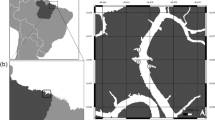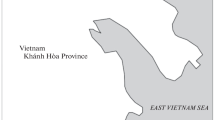Abstract
We present here a morpho-functional and behavioural study of the feeding adaptations developed by a deep-sea invertebrate, the caprellid amphipod Parvipalpus major, in an environment temporarily deprived of external food supply. The animals were taken intact from bathyal muddy sediments using a classic Barnett multi-tub corer at depths ranging from 424 to 761 m. They were transferred to the laboratory, kept in tanks with their native sediment at a constant temperature (10°C) and their behaviour was studied by video analysis. Their morphology consists of elongated somites, with pereopods 5–7 ending in elongated curved dactyls, which are longer than those of more coastal species. Analysis of the literature shows that the largest caprellids inhabit the deepest and muddiest zones. This particular morpho-functional adaptation enables the species to adopt an originally erect and steady stance by fixing onto soft muddy sediment, thus improving its ability to prospect for food in its surrounding environment. For the most part, P. major balances its body at its anchorage point as it searches for food in the water column, but occasionally it bends down to the substrate, and tosses some sediment into the water column. Food is then selected from the particles that float down. Presumably, after exhausting the food supply in one area, the animal jumps into the water column and moves about a body length further on. This would appear to be an original strategy for foraging larger areas of organic matter from fixed, but temporary, positions. Finally, we show that caprellids are able to practise coprophagy. To conclude, we suggest that there is a positive correlation between body elongation and depth, with improved anchoring and coprophagy being an optimal way to conserve energy in conditions of limited diet and improve adaptation to life on deep-sea muddy bottoms.







Similar content being viewed by others
References
Barnett PRO, Watson J, Connely D (1984) A multiple corer for taking virtually undisturbed samples from shelf, bathyal and abyssal sediments. Oceanol Acta 7:399–408
Bellan-Santini D, Ruffo S (1998) Faunistics and zoogeography. In: Ruffo S (ed) The Amphipoda of the Mediterranean, part 4. Mem Inst Oceanogr (Monaco) 13:895–912
Britton JC, Morton B (1994) Marine carrion and scavengers. Oceanogr Mar Biol Annu Rev 32:369–434
Caine EA (1974) Comparative functional morphology of feeding in three species of caprellids (Crustacea, Amphipoda) from the northwestern Florida gulf coast. J Exp Mar Biol Ecol 15:81–96
Caine EA (1977) Feeding mechanisms and possible resource partioning of the Caprellidae (Crustacea: Amphipoda) from the Puget Sound, USA. Mar Biol 42:331–336
Caine EA (1978) Habitat adaptations of North American caprellid Amphipoda (Crustacea). Biol Bull (Woods Hole) 155:288–296
Carausu A (1941) Notes sur quelques caprellides des eaux françaises et monégasques. Bull Inst Oceanogr (Monaco) 803:1–15
Chevreux E, Fage L (1925) Faune de France, vol 9: Amphipodes. Office central de faunistique, Paris
Chong PLG, Cossins AR (1983) A differential polarized phase fluorometric study of the effect of high hydrostatic pressure upon the fluidity of cellular membranes. Biochemistry 22:409–415
Chong PLG, Fortes AG, Cossins AR (1985) Mechanisms of inhibition of (Na-K)-ATPase by hydrostatic pressure studied with fluorescent probes. J Biol Chem 260:14484–14490
Corbari L, Sorbe JC (2001) Structure of the suprabenthic assemblages in the Capbreton area (SE of the Bay of Biscay). In: Elbée J, Prouzet P (eds) Océanographie du golfe de Gascogne VIIe Colloq Int. IFREMER (Inst Fr Rech Exploit Mer) Actes Colloq 31:87–95
Dauvin JC, Sorbe JC (1995) Suprabenthic amphipods from the southern margin of the Cap-Ferret Canyon (Bay of Biscay, northeastern Atlantic Ocean): abundance and bathymetric distribution. Pol Arch Hydrobiol 42:441–460
Dauvin JC, Sorbe JC, Lorgere JC (1995) Benthic boundary layer macrofauna from the upper continental slope and the Cap-Ferret canyon. Oceanol Acta 18:113–122
Gage JD, Tyler PA (1991) A natural history of the organisms at the deep-sea floor. Cambridge University Press, Cambridge
Guerra-García JM (2001) Habitat use of the Caprellidea (Crustacea: Amphipoda) from Ceuta, North Africa. Ophelia 55:27–38
Guerra-García JM (2003) Two new species of deep-water caprellids (Crustacea: Amphipoda) from north-eastern Brazil. Cah Biol Mar 44:171–184
Guerra-García JM, García-Asencio I, Sánchez-Moyano JE (2001a) Parvipalpus onubensis, a new species (Crustacea: Amphipoda: Caprellidea) from the Atlantic coast of southern Spain. Sci Mar 65:333–339
Guerra-García JM, Sánchez-Moyano JE, García-Gómez JC (2001b) Two new species of Caprella (Crustacea: Amphipoda: Caprellidea) collected on sandy bottoms in the Strait of Gibraltar. Hydrobiologia 448:181–192
Guerra-García JM, Corzo J, García-Gomez JC (2002) Clinging behaviour of the Caprellidea (Amphipoda) from the Strait of Gilbraltar. Crustaceana 75:41–50
Henriques C, Priede IG, Bagley PM (2002) Baited camera observations of the deep-sea demersal fishes of the Northeast Atlantic Ocean at 15–28°N off West Africa. Mar Biol 141:307–314
Hudson I, Wigham B (2003) In situ of predatory feeding behaviour of the galatheid squat lobster Munida sarsi (Huus, 1935) using a remotely operated vehicle. J Mar Biol Assoc UK 83:4264–4265
Hudson IR, Wigham BD, Tyler PA (2004) The feeding behaviour of a deep-sea holothurian, Stichopus tremulus (Gunnerus) based on in situ observations and experiments using a remotely operated vehicle. J Exp Mar Biol Ecol 301:75–91
Jumars PA, Self RFL, Nowell ARM (1982) Mechanics of particle selection by tentaculate deposit feeders. J Exp Mar Biol Ecol 64:47–70
Keith DE (1969) Aspects of feeding in Caprella californica Stimpson and Caprella equilibra Say (Amphipoda). Crustaceana 16:119–124
Klages M, Muyakschin S, Soltwedel T, Arntz WE (2002) Mechanoreception: a possible mechanism for food fall detection in deep-sea scavengers. Deep-Sea Res 49:143–155
Krapp-Schickel G (1993) Suborder Amphipoda Caprellidea. In: Ruffo S (ed) The Amphipoda of the Mediterranean, part 3 Mem Inst Oceanogr (Monaco) 13:802–804
Larsen K (1998) Caprellidea (Crustacea; Amphipoda) from Faroe Islands waters, with a key to the North Atlantic species. Fróðskaparrit 46:81–90
Laubitz DR (1970) Studies on the Caprellidae (Crustacea, Amphipoda) of the American North Pacific National Museum of Natural Sciences. Can Publ Biol Oceanogr 1:1–89
Laubitz DR (1972) The Caprellidae (Crustacea, Amphipoda) of the Atlantic and Arctic. Can Publ Biol Oceanogr 4:1–82
Laubitz DR, Mills EL (1972) Deep-sea Amphipoda from the western North Atlantic Ocean: Caprellidea. Can J Zool 50:371–383
Laubitz DR, Sorbe JC (1996) Deep-water caprellids (Amphipoda: Caprellidea) from the Bay of Biscay: a new species and a new locality record. J Crustac Biol 16:626–632
Lindsay SM, Woodin SA (1995) Tissue loss induces switching of feeding mode in spionid polychaetes. Mar Ecol Prog Ser 125:159–169
Marquiegui MA, Sorbe JC (1999) Influence of the near-bottom environmental conditions on the structure of the bathyal macrobenthic crustacean assemblages from the Capbreton canyon (Bay of Biscay, NE Atlantic). Acta Oecol Int J Ecol 20:353–362
Mayer LM, Jumars PA, Taghon GL, Macko S, Trumbore S (1993) Low-density particles as potential nitrogenous foods for benthos. J Mar Res 51:373–389
McCain JC (1966) Abyssicaprella galatheae, a new genus and species of abyssal caprellid (Amphipoda: Caprellidae). Galathea Repl 8:91–95
McCain JC (1968) The Caprellidae (Crustacea: Amphipoda) of the western North Atlantic. Bull US Natl Mus 278:1–147
Mulder T, Weber O, Anschutz P, Jorissen J, Jouanneau JM (2001) A few months-old storm-generated turbidite deposited in the Capbreton Canyon (Bay of Biscay, S-W France). Geo-Mar Lett 21:149–156
Myers AA, Lowry JK (2003) A phylogeny and new classification of the Corophiidea (Amphipoda). J Crustac Biol 23:443–485
Ogawa N, Tauzin P (1973) Contribution à l’étude hydrologique et géochimique du Gouf de Capbreton. Bull Inst Géol Bassin Aquitaine 14:19–46
Patton WK (1968) Feeding habits, behaviour and host specificity of Caprella grahami, an amphipod commensal with the starfish Asterias forbesi. Biol Bull (Woods Hole) 134:148–153
Somero G (1991) Hydrostatic pressure and adaptations to the deep sea. In: Ladd Prosser C (ed) Comparative environmental and metabolic animal physiology. Wiley-Liss, New York, pp 163–203
Sorbe JC (1983) Description d’un traîneau destiné à l’échantillonnage quantitatif étagé de la faune suprabenthique néritique. Ann Inst Oceanogr 59:117–126
Sorbe JC (1991) Biología del misidáceo suprabentónico Schistomysis ornata (Sars, 1864) en la plataforma continental aquitana (suroeste de Francia). In: Actas V Simp. Ibér. Estud. Bentos Mar. La Laguna University, Puerto de las Cruz, pp 273–298
Svavarsson J, Brattegard T, Stronberg JO (1990) Distribution and diversity patterns of asellote isopods (Crustacea) in the deep Norwegian and Greenland Seas. Prog Oceanogr 24:297–310
Takeuchi I, Hirano R (1995) Clinging behaviour of the epifaunal caprellids (Amphipoda) inhabiting the Sargassum zone on the Pacific coast of Japan with its evolutionary implications. J Crustac Biol 15:481–492
Takeuchi I, Takeda M, Takeshita K (1989) Redescription of the bathyal caprellid, Caprella ungulina Mayer, 1903 (Crustacea, Amphipoda) from the North Pacific. Bull Natl Sci Mus (Tokyo) 15:19–28
Wirtz P, Vader W (1996) A new caprellid–starfish association: Caprella acanthifera s.l. (Crustacea: Amphipoda) on Ophidiaster ophidianus and Hacelia attenuata from the Azores. Life Mar Sci 14:17–22
Acknowledgements
The authors are most grateful to the crew members of the R.V. “Côtes de la Manche” for their help in field research. This study was partially supported by CIRMAT-CNRS (OXYBENT 10 and SEDICAN 1–2 oceanographic cruises and loan of the “Roscoff” suprabenthic sled). Thanks to S. Ruffo, W. Vader, I. Takeuchi, D. Platvoet, P. Jumars, L. Watling and F. Carlotti for valuable discussions. S. Walther and A. Ranasinghe (Southern California Bight Regional Monitoring Program) provided ecological information on the Californian caprellid Mayerella banksia.
Author information
Authors and Affiliations
Corresponding author
Additional information
Communicated by S.A. Poulet, Roscoff
Rights and permissions
About this article
Cite this article
Corbari, L., Sorbe, J.C. & Massabuau, JC. Video study of the caprellid amphipod Parvipalpus major: morpho-functional and behavioural adaptations to deep-sea bottoms. Marine Biology 146, 363–371 (2005). https://doi.org/10.1007/s00227-004-1433-4
Received:
Accepted:
Published:
Issue Date:
DOI: https://doi.org/10.1007/s00227-004-1433-4




